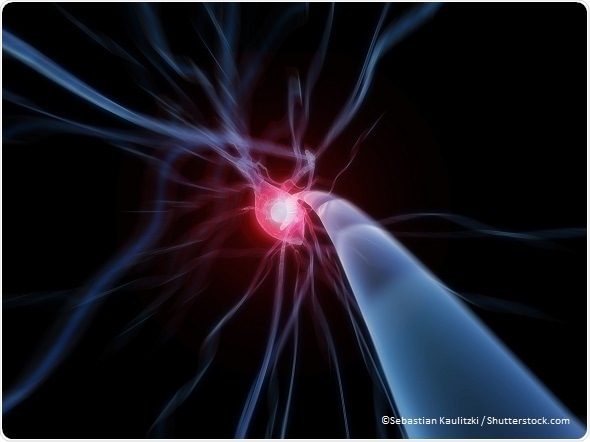For All The Latest Medical News, Health News, Research News, COVID-19 News, Dengue News, Glaucoma News, Diabetes News, Herb News, Phytochemical News, Cardiology News, Epigenetic News, Cancer News, Doctor News, Hospital News
Peripheral neuropathy is a term used to describe conditions in which there is weakness or injury to the muscles and sensory organs because of damage to the nerves that supply them - the peripheral nervous system.

A tremor may appear in a patient with peripheral neuropathy - neuropathic tremor (NT). It may be the presenting feature in polyneuropathies, or in other diseases which affect the peripheral nerves. In these cases, the tremor occurs because of exaggeration of the physiological or normal tremor as a result of weakness to a minimal degree.
The nerves to the peripheral muscles and sensory organs may be damaged by disease or injury, higher levels of nervous dysfunction, or systemic disease. NT may be seen in certain areas only, typically the upper limb, or over the whole body.
A tremor of minimal amplitude is the only consistent clinical finding seen in all patients with NT.
Tremor associated with peripheral neuropathy has the following characteristics:
Peripheral neuropathy occurs in various conditions such as:
In most cases the high serum immunoglobulins are due to monoclonal gammopathy of unknown etiology. Other conditions which should be diagnosed include amyloidosis, plasmacytoma, or malignancies of the lymphoreticular system.
NT may have different mechanisms of action, depending on the etiology. For instance, when the sensory input is impaired or altered, the resulting misinformation may cause tremor despite the brain and spinal cord functioning correctly.
In another situation, abnormal sensory data may lead to unnecessary compensation by the cerebellum to correct limb position and velocity of movement, which further aggravates and continues the misleading input. This leads to the development of a variable tremor.
Yet again, there may be faulty motor output from the oscillatory neurons of the motor cortex of the brain which causes the muscles of the limb to respond with a postural tremor in the case of NT.
The fact that deep brain stimulation (DBS) at a high frequency suppresses the tremor has led many scientists to conclude that the processing of motor neuron outputs in the deep thalamic nuclei of the brain is faulty in NT. Such tremors are more likely to be refractory to treatment.
Postural or kinetic tremor of minimal amplitude is typically a presenting or chief sign in NT. The diagnosis is suggested by the presence of other signs of neuropathy. Confirmation may require serum electrophoresis for abnormal serum proteins, electrophysiological studies such as electromyography (EMG), cerebrospinal fluid (CSF) examination for signs of infection, inflammation, or tumor, and in some cases, nerve biopsy.
It is important to diagnose the condition early so that timely treatment can be provided. This can help reverse some underlying medical causes.
Medical treatment of NT has focused on the use of a beta-blocker and a anticonvulsant. However, their use has not met expectations.
Other more successful therapies include deep brain stimulation of the nucleus ventralis intermedius of the thalamus, with benefit being reported in the form of 30-50% reduction in tremor intensity. Side effects at higher charges include increasing gait ataxia. However, at the right levels, marked improvement has been reported in activities of daily living and in the amplitude of the tremor. Especially significant is the fact that the corticomuscular coherence of the contralateral motor cortex and the tremulous limb muscle disappears completely with DBS. More study is required in this area.
In conditions associated with high serum immunoglobulin levels, immunosuppressive therapies may be useful. These include corticosteroids, intravenous immunoglobulin administration, cyclophosphamide, or plasma exchange.
Factors which are considered to enhance tremor should be removed from the lifestyle or diet, such as excessive fatigue, and stimulants such as caffeine.
Physical therapy is sometimes useful as it assists the individual in regaining some control of coordinated muscular activity. It may help, for instance, by teaching one how to brace the limb against a tremor, or to keep the tremulous part close to the body. Exercises to restore coordination and equilibrium, as well as occupational therapy, can help others to adjust their lifestyle to the condition while alleviating its more severe effects on muscle strength and control, as well as skills for daily functioning.